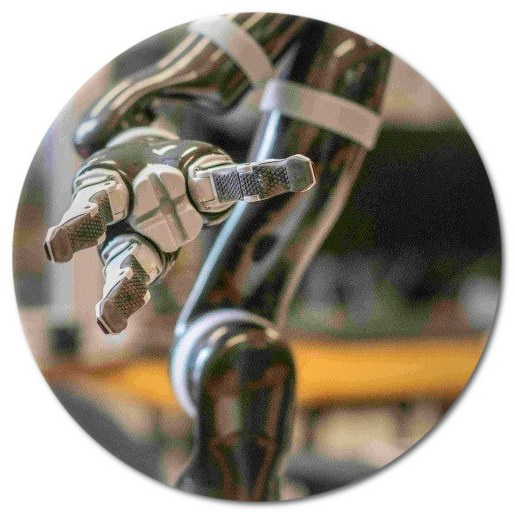 Develop knowledge of the foundations, applications, and impacts of technology in the Digital Age
Develop knowledge of the foundations, applications, and impacts of technology in the Digital Age
One of the distinguishing features of humans is our ability to build technologies in the hope of improving our collective condition. Pure science, applied mathematics, algorithms, and software provide foundations that enable new discoveries of components, tools, and applications ranging from large-scale transportation systems to new manufacturing technologies to small-scale digital communication systems.
Profound changes have occurred in the ways in which we interact using technology and in our expectations of what technology will deliver in terms of speed and content. Advances in broadband and communication technologies continue to expand communication between non-humans – the “Internet of things” – while advances in machine learning and artificial intelligence open up new ways for humans to communicate with and rely on machines for an increasingly broad range of tasks. Even before recent technological advances – digital media, big data, and the use of wireless and optical networks – questions, such as “How do we make sense of the previously unimaginable amounts of information now at our fingertips?” and “How can individuals, businesses, and organizations utilize technologies to improve how they function?” have long been at the centre of McGill research.
Our work in the fields of mathematics, physics, and engineering enables a wide spectrum of industrial-technological applications. Our work in social sciences and humanities helps us better understand technology’s role in societal institutions, such as education and health care, and changes to society, such as those to labour markets, commodity supply chains, and the sharing economy. The impacts on society of present and future technologies are potentially profound. The social, ethical and legal frameworks to respond to and navigate these impacts are yet to be articulated – they are a wonderfully rich and important research frontier.
Image: Robot arm in the Centre for Intelligent Machines (Olivier Blouin)
Examples of Research Areas:
Artificial Intelligence
Specifically machine learning – the study of algorithms that can learn from data and experience, such as for natural language processing – is a growing focus at McGill. Our researchers work on the development of reinforcement learning systems, which have the ability to interact with an environment and learn from this interaction to achieve specified goals. Applications of machine learning span diverse areas, such as robotics and automated dialog systems as well as life sciences, medical imaging, clinical monitoring, and various other domains of scientific, social and commercial interest.
Robotics
A cornerstone for research in the allied disciplines of artificial intelligence and computer vision. Core elements of McGill’s research activities in robotics emphasize the use of robust autonomous locomotion, sensing, environmental inference, and learning, as well as the interaction of robotic systems with the world around them. Our research activities address the manner in which robots can learn more and move more efficiently, the ways in which behavioural knowledge can be abstracted and transferred between one domain and another, and the ways in which teams of robotic systems can jointly achieve a task with increasing efficiency.
New Musical Forms
New musical forms have appeared that are mostly, or totally, based on digital technologies, transforming the way we think, generate, and interact with sounds. We study how expert musicians develop, or adapt, their music performance skills when interacting with technology. Discoveries in this domain create novel technologies that fulfill the needs of highly-skilled musicians, allowing them to perform in an expressive way, independently of the form that the music takes now or in the future.
Additive Manufacturing
Also known as 3D printing, is a layer-by-layer fabrication technology. McGill researchers are developing fast and precise digital pre-manufacturing solutions, by integrating physics-based process modeling with optimization algorithms and validating their manufacturability on industrial platforms. The wide variety of research applications of additive manufacturing is touching all fields of materials manufacturing.
Optical fiber communication systems
The backbone of the connected world. Virtually all information transmitted over the global communications network is represented as binary data and transformed into optical pulses. The rapid increase in demand for connectivity can only be met by continued innovation in optical fiber communications systems. McGill researchers are working to produce breakthroughs both in “long-reach systems” (transmission distances between 300 and 6,000 km) and “short-reach systems” (transmission distances of 2 to 300 km). The research effort capitalizes on the synergies that exist between the two systems and adopts a mix of theoretical, analytic, simulation, and experimental research using state-of-the-art experimental optical fiber transmission test beds.
Optical fiber communication systems
The backbone of the connected world. Virtually all information transmitted over the global communications network is represented as binary data and transformed into optical pulses. The rapid increase in demand for connectivity can only be met by continued innovation in optical fiber communications systems. McGill researchers are working to produce breakthroughs both in “long-reach systems” (transmission distances between 300 and 6,000 km) and “short-reach systems” (transmission distances of 2 to 300 km). The research effort capitalizes on the synergies that exist between the two systems and adopts a mix of theoretical, analytic, simulation, and experimental research using state-of-the-art experimental optical fiber transmission test beds.